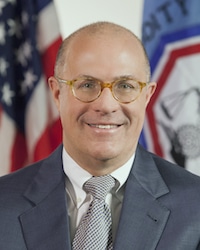The futures market is increasingly going to set the price for Bitcoin and other crypto-assets as more contracts are launched according to market participants.
Christopher Giancarlo, former chairman of the Commodity Futures Trading Commission and presently senior counsel at law firm Willkie Farr & Gallagher, moderated a panel, ‘Crypto Becomes Mainstream’, at FIA Boca on March 17.
He noted that in most major commodities markets, such as oil or soybeans, the price is not set at the point of sale in the spot market but in futures markets where all interests can be brought to bear at the same time.
Giancarlo said: “The launch of Bitcoin futures has led to more pricing being set in the futures market, rather than the retail market, and I think that is a trend that will continue.”
Colleen Sullivan, chief executive and and co-founder of CMT Digital which is focused on crypto asset trading and blockchain technology investments, agreed. She said on the panel; “We are seeing that and we expect it to continue as the industry continues to grow and mature.”
CME Group introduced Bitcoin futures in December 2017 and added Bitcoin options in January 2020. The exchange also launched ether futures on February 8 2021.
Sullivan continued that the launch of Bitcoin futures broadened the ability for new institutional participants to enter the crypto market. Prior to their introduction retail investors and some proprietary trading firms accessed crypto derivatives on unregulated offshore exchanges, which was not possible for regulated financial institutions managing third-party capital.

‘The launch of Bitcoin futures on CME also allowed institutions to access these products through existing futures clearing merchant channels, just as they do for any other derivative,” she added. “The futures are also cash-settled which eliminates a lot of the operational risk and complexity that goes along with dealing in the crypto spot market.”
Tom Jessop, president of Fidelity Digital Assets, said on the panel that the launch of futures validated an emerging asset class. Fidelity Digital Assets is the unit within the $7 trillion asset manager that is aiming to create an enterprise-grade platform for storing, trading, and supporting eligible digital assets.
“You can’t underestimate the value of institutions being able to get exposure to this asset class in a familiar form on a regulated exchange and being able to integrate those exposures into their investment strategy or overall risk management,” he added.
Jessop continued that the market is very early in adoption as the CME bitcoin future had open open interest of approximately $2.5bn at the end of February, with about 75 large open interest holders.

Fidelity Digital Assets
“The CME contract is now about 10% or 15% of global open interest from about zero and growth has been almost exclusively institutional ,” Jessop said. “Despite all the success it’s still quite early in terms of adoption, which I am very excited about.”
Zac Prince, chief executive and founder of BlockFi, said on the panel that the introduction of futures also benefitted retail investors through validating the asset class and providing risk management. BlockFi provides credit services in cryptocurrency to markets with limited access to simple products like a savings account.
“The biggest impact it had directly on BlockFi platform and with our retail clients is that it sparked this really large wave of institutional adoption,” added Prince. “Bitcoin futures created the need for institutions to borrow these assets, so we created a new retail-facing product which has been incredibly popular, where owners can earn a yield on their bitcoin holdings.”
DeFi potential
Sullivan highlighted the growth in decentralised finance. DeFi, or Open Finance, uses smart contacts automatically executing on blockchains to allow any user to stake cryptocurrency as collateral on a platform and provide services such as lending or liquidity without the involvement of a traditional financial intermediary.
For example, she said that Uniswap is the most popular fully decentralized protocol for automated liquidity provision on Ethereum.
“On March 15 Uniswap had volumes of about $1.1bn and Coinbase had $3.1bn,” Sullivan added. “A year ago Uniswap’s daily volume was only $22m and Coinbase was $814m.”
Coinbase is the largest retail platform for buying, selling and storing cryptocurrency, which has recently filed to list and go public. In addition, Sullivan said Uniswap generates the most fees of any DeFi protocol and is on track to earn about $1.5bn on an annualised basis. In addition, total value locked in DeFi smart contracts is about $43bn, up from only $530m a year ago.
“I share these figures to show that DeFi is growing rapidly and it’s not really a fringe experiment at this point,” she added.
However Sullivan highlighted that is is difficult to regulate a fully decentralised protocol like Uniswap which is unlikely to fit into the traditional market structure.
Regulation
Sullivan continued that the CFTC’s self-certification framework which authorized crypto futures provides clear evidence of how regulatory clarity can encouraging market-driven innovation and pave the way for participation from traditional financial market participants.
Jessop said: “Regulation is clearly perceived as a potential headwind. Having said that, I think we’ve seen a lot of progress over the past six months, certainly in the US, starting with what the OCC has done to clarify the role that banks can play in this ecosystem.”
In January 2021 the Office of the Comptroller of the Currency clarified that national banks and federal savings associations could participate in independent node verification networks and use stablecoins to conduct payment activities and other bank-permissible functions.

Giancarlo commented that Gary Gensler, nominated chairman of the US Securities and Exchange Commission, will bring an emphasis on investor protection and perhaps, a greater openness to crypto innovation.
Gensler is a professor of the practice of Global Economics and Management at MIT Sloan School of Management and co-director of MIT’s Fintech@CSAIL, which collaborates with industry and also senior advisor to the MIT digital currency initiative, researching artificial intelligence, blockchain technology, and new financial technologies. He is also a former chairman of the CFTC.
Prince noted that many Americans are already participating in cryptocurrencies through non-regulated venues.
“We are working with the US regulatory environment and doing all the same things that investment platforms in the commodities or securities spaces would in terms of disclosures and consumer protection,” Prince added.
Giancarlo also highlighted that in the US, Ranking Member Patrick McHenry of the House Financial Services Committee and his Democratic colleague, Stephen Lynch from Massachusetts, have introduced a bill that would deputize the CFTC and the SEC to work together on a crypto regulatory committee report to Congress.
Sullivan was pessimistic that the US will implement a new regulatory regime bespoke to crypto. “We’ve been advocating for something like that for the last eight years and I just don’t see it happening,” she said.
Her reasons were that the crypto ecosystem grew from the retail, rather than the institutional sector, and crypto-assets are fungible across exchanges.
“Systems like Bitcoin are just software code running autonomously on the internet, there’s no Bitcoin LLC that regulators can find or shut down,” she added. “There’s no Bitcoin CEO that regulators can call up if they have a problem.”
Giancarlo agreed that regulators look at the ecosystem and its intermediaries so DeFi is a huge challenge.
“I think it’s going to be a really important objective for regulators going forward to not be a break on this innovation but to find a new way,” he said. “I would suggest that the way forward is to focus less on actors, and focus more on actions that are subject to regulation.”



